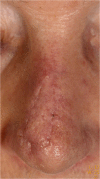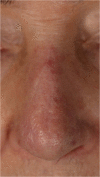Fractional CO2 laser to improve noticeable scars after skin cancer surgery: An appraisal by the patients, laypersons, and experts
- PMID: 34022110
- PMCID: PMC8459294
- DOI: 10.1111/dth.14999
Fractional CO2 laser to improve noticeable scars after skin cancer surgery: An appraisal by the patients, laypersons, and experts
Abstract
Ablative fractionated carbon dioxide (fCO2 ) laser may be a useful tool to improve noticeable scars after skin cancer surgery. Therefore we evaluated 40 patients who have been treated with fCO2 laser for facial scars after skin cancer surgery. This retrospective study is based on blinded evaluation of pre- and postoperative photographs. Patients (n = 40), laypersons (n = 5) and experts (n = 5) evaluated the esthetics and the Vancouver scar scale as primary endpoints. Secondary endpoints included patient satisfaction and treatment safety. Patients, laypersons and experts consistently assessed a significant improvement of scar quality and appearance after fCO2 laser treatment, which was paralleled by high patient satisfaction. In conclusion, ablative fCO2 laser is effective in improving noticeable postsurgical scars. Patients are highly satisfied with post-laser results.
Keywords: facial scars; fractional CO2 laser treatment; skin cancer surgery.
© 2021 The Authors. Dermatologic Therapy published by Wiley Periodicals LLC.
Conflict of interest statement
The authors declare no potential conflict of interest.
Figures






Similar articles
-
Early postoperative single treatment ablative fractional lasing of Mohs micrographic surgery facial scars: a split-scar, evaluator-blinded study.Lasers Surg Med. 2015 Jan;47(1):1-5. doi: 10.1002/lsm.22314. Epub 2015 Jan 5. Lasers Surg Med. 2015. PMID: 25559589 Clinical Trial.
-
Fractional carbon dioxide laser resurfacing of skin grafts: long-term results of a prospective, randomized, split-scar, evaluator-blinded study.Lasers Surg Med. 2018 Dec;50(10):1010-1016. doi: 10.1002/lsm.22950. Epub 2018 Jun 17. Lasers Surg Med. 2018. PMID: 29911321 Clinical Trial.
-
Comparison of the Scar Prevention Effect Between a Carbon Dioxide Fractional Laser and a Continuous Ablative Carbon Dioxide Laser with a 595-nm Nd:YAG Laser.Aesthetic Plast Surg. 2019 Feb;43(1):213-220. doi: 10.1007/s00266-018-1210-2. Epub 2018 Aug 21. Aesthetic Plast Surg. 2019. PMID: 30132109
-
Comparative appraisal with meta-analysis of erbium vs. CO2 lasers for atrophic acne scars.J Dtsch Dermatol Ges. 2021 Nov;19(11):1559-1568. doi: 10.1111/ddg.14546. Epub 2021 Sep 23. J Dtsch Dermatol Ges. 2021. PMID: 34558190 Review.
-
The efficacy and safety of fractional CO2 laser therapy in the treatment of burn scars: A meta-analysis.Burns. 2021 Nov;47(7):1469-1477. doi: 10.1016/j.burns.2021.08.010. Epub 2021 Aug 20. Burns. 2021. PMID: 34493423 Review.
Cited by
-
Evaluating the combination and comparison of ablative fractional lasers (CO2, Erbium-YAG) with pulsed dye laser (PDL) for treating hypertrophic scars: a systematic review.Lasers Med Sci. 2025 Mar 8;40(1):129. doi: 10.1007/s10103-025-04382-2. Lasers Med Sci. 2025. PMID: 40055224
-
Clinical Observation of Sequential Laser Therapy Combined with Tension Reducer for Postoperative Tension Incision Scar Growth.Clin Cosmet Investig Dermatol. 2023 Jan 7;16:59-65. doi: 10.2147/CCID.S392461. eCollection 2023. Clin Cosmet Investig Dermatol. 2023. PMID: 36643387 Free PMC article.
References
-
- Ngaage M, Agius M. The psychology of scars: a mini‐review. Psychiatr Danub. 2018;30(7):633‐638. - PubMed
-
- Anderson RR, Donelan MB, Hivnor C, et al. Laser treatment of traumatic scars with an emphasis on ablative fractional laser resurfacing: consensus report. JAMA Dermatol. 2014;150(2):187‐193. - PubMed
-
- Baca ME, Neaman KC, Rapp DA, Burton ME, Mann RJ, Renucci JD. Reduction of post‐surgical scarring with the use of ablative fractional CO2 lasers: a pilot study using a porcine model. Lasers Surg Med. 2017;49(1):122‐128. - PubMed
-
- Cervelli V, Gentile P, Spallone D, et al. Ultrapulsed fractional CO2 laser for the treatment of post‐traumatic and pathological scars. J Drugs Dermatol. 2010;9(11):1328‐1331. - PubMed
MeSH terms
Substances
LinkOut - more resources
Full Text Sources
Other Literature Sources
Medical

